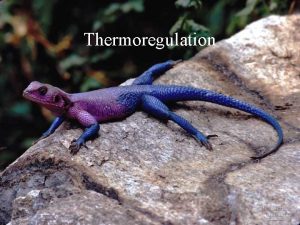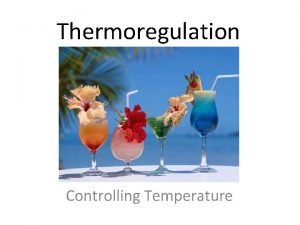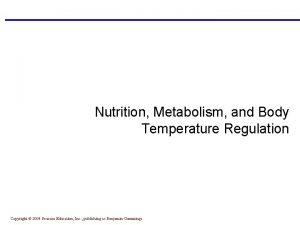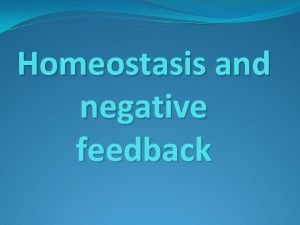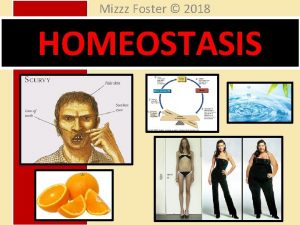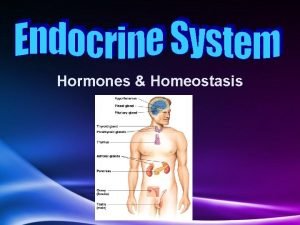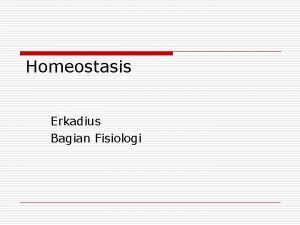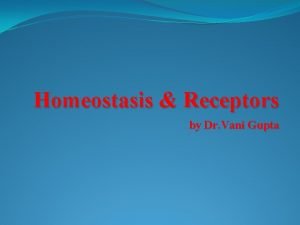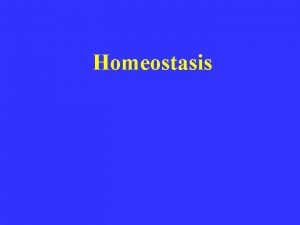28 2 Mechanisms of Homeostasis KEY CONCEPT Homeostasis












- Slides: 12

28. 2 Mechanisms of Homeostasis KEY CONCEPT Homeostasis is maintaining stable internal conditions.

28. 2 Mechanisms of Homeostasis Warm up: • List 4 systems of the body and how they help maintain homeostasis.

28. 2 Mechanisms of Homeostasis Body conditions must remain within a narrow range. Ex: body temp 96 -102 degrees F (normal range) • Homeostasis involves keeping internal conditions within normal ranges (body temp, blood p. H, blood sugar levels, etc. )

28. 2 Mechanisms of Homeostasis What happens when your body gets to hot?

28. 2 Mechanisms of Homeostasis What happens when your body gets too cold?

28. 2 Mechanisms of Homeostasis What system works to help maintain your body temperature?

28. 2 Mechanisms of Homeostasis Negative feedback loops are necessary for homeostasis. • Negative feedback counteracts change (response opposes stimulus). • The nervous system senses when the body gets too hot, and communicates signals to cool down. Negative Feedback Loop Holding breath, CO 2 levels rise O 2 / CO 2 level returns to normal Control system forces exhale, inhale

28. 2 Mechanisms of Homeostasis Which arrows show a return to normal after a negative feedback loop was activated?

28. 2 Mechanisms of Homeostasis What happens when you cut yourself and you start to bleed?

28. 2 Mechanisms of Homeostasis • Positive feedback increases change (response amplifies stimulus). Stimulus Response A Response C (more of A and B) Response B

28. 2 Mechanisms of Homeostasis Positive feedback moves the body further away from homeostasis to accomplish a goal. • Examples: – Childbirth - Oxytocin (a hormone) stimulates contractions - Contractions stimulate release of more oxytocin - Contractions increase in frequency and strength until baby is born – Blood clotting - Bleeding stimulates production of chemicals - Clotting begins, causing release of additional chemicals that accelerate clotting - Continues until bleeding stops platelets blood vessel fibrin clot red blood cell white blood cell

28. 2 Mechanisms of Homeostasis Next: • You are going to create a brochure that describes either a positive or a negative feedback loop. • You are a pharmaceutical company and you are trying to sell your product. • Make sure and include all systems that are involved in the process. • Explain how your product maintains homeostasis inside the body.
 Countercurrent exchange thermoregulation
Countercurrent exchange thermoregulation Body temperature maintenance
Body temperature maintenance Nutrition metabolism and body temperature regulation
Nutrition metabolism and body temperature regulation Negative feedback communication
Negative feedback communication Bioflix activity homeostasis low blood glucose
Bioflix activity homeostasis low blood glucose Bioflix activity homeostasis high blood glucose
Bioflix activity homeostasis high blood glucose Chapter 4 lesson 4: metamorphic rocks answer key
Chapter 4 lesson 4: metamorphic rocks answer key Lesson 1 waves answer key
Lesson 1 waves answer key Which key activities do partners perform
Which key activities do partners perform Key partners
Key partners An ideal self must not deviate from real self. justify
An ideal self must not deviate from real self. justify Pengertian marketing concept
Pengertian marketing concept Mechanisms of movement lab report
Mechanisms of movement lab report
